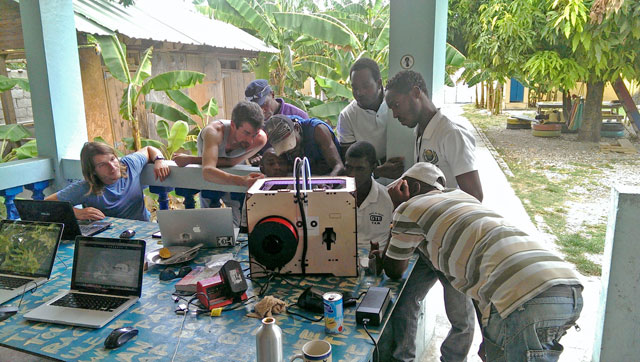Advocates of 3D printing fall into different categories. Some see the tech as a means of creating custom tailored goods, necessary in the ever-personalized world of web 2.0. Others are keen on the efficiency and complexity of design brought about by 3D printing. And still others see it as a means of improving the lives of the less fortunate. iLab//Haiti clearly falls into this last category.
The non-profit is the result of a partnership between Haiti Communitere, KIDmob, and The Blue Marble Movement and they hope to respond to the humanitarian crisis in Haiti with the use of digital technology, stating: “Our group does not propose to know what Haiti needs. We have been exposed to tools and ways of thinking that are of value globally. These tools offer potential to sidestep certain infrastructures and broken systems. We are here to provide access to digital technologies and our design framework. We are here to let Haitians, the people that know best what Haiti needs, decide how to leverage these tools.” To execute their goal of providing access, iLab//Haiti has already brought the country its first two 3D printers, both Makerbot Replicator 1s, and have begun teaching the use of Rhino and SketchUp. By the end of the month, they will have two more Replicators and they plan on teaching Autodesk Inventor, as well.

After looking at a Reddit thread discussing this, it’s clear that some issues will still come up in regards to 3D printing in Haiti, such as power failures in the country. So, in the comments below, tell us what you think the benefits of 3D printing in Haiti might be, as well as the difficulties that iLab//Haiti might face.
I, for one, can see the advantages to 3D printing some objects on demand in a medical clinic. For a brief period of time, I ran my family’s clinic in Bolivia, located about an hour away from the nearest large city. I can imagine a patient coming in from a village hundreds of kilometers away with an injured set of fingers. Though the injury could be treated easily in a major hospital, the clinic might have run out of splints. As it stands, the solution would be to fashion an uncomfortable splint out of tongue depressors and tape or to drive to the city, visit a medical supplier (who may need to order the splints themselves) and return to the clinic a few hours later to find that the patient has already left. With a 3D printer, however, the wait time would only be about an hour. And, as the technology improves and the clinic’s volunteers become more adept, more functional objects can be created, such as prosthetic hands.
If you want to donate time, money, or equipment (an old Replicator or Prusa, perhaps?), visit iLab//Haiti here.
Source: Make



